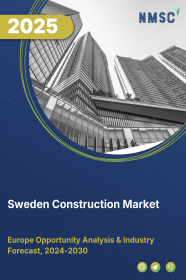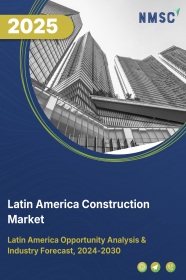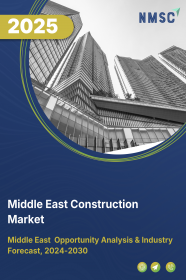
Sweden Construction Market by Type (Renovation, and New Construction), by Sector (Real Estate and Others), by Construction Method (Traditional Construction, Prefabricated/Modular Construction, 3D Printed Construction, Green/Sustainable Construction), and by Type of Contractor (Large Contractor, Medium Contractor and Small Contractor) – Country Industry Trends and Forecast, 2025–2030
Industry: Construction & Manufacturing | Publish Date: 21-Jun-2025 | No of Pages: 153 | No. of Tables: 117 | No. of Figures: 62 | Format: PDF | Report Code : CM2206
Sweden Construction Industry Overview
The Sweden Construction Market size was valued at USD 49.30 billion in 2024, and is projected to grow to USD 56.54 billion by 2025. Additionally, the industry is expected to continue its growth trajectory, reaching USD 77.80 billion by 2030, with a CAGR of 6.6% from 2025 to 2030.
Sweden construction market is experiencing strong growth, primarily fueled by government-backed infrastructure projects aimed at enhancing the country's railway and transportation systems.
The launch of a national infrastructure investment plan and major rail initiatives are reinforcing sustainable mobility and regional connectivity. This sector’s substantial contribution to Sweden’s GDP reflects its central role in the nation's economic development.
However, the market faces notable challenges from complex regulatory frameworks that slow project execution and inflate costs. Amid these hurdles, the increasing adoption of digital tools such as Building Information Modeling (BIM), along with AI, IoT, and cloud integration, is creating new opportunities for improved collaboration, efficiency, and digital transformation across construction activities.
Government-Backed Infrastructure Projects Drive Sweden’s Construction Market Growth
Sweden's construction sector is experiencing notable growth, underpinned by a surge in government-supported infrastructure initiatives. These efforts are primarily concentrated on enhancing national transportation systems—particularly railways—and are serving as major catalysts for market expansion.
In December 2024, the Swedish government approved a comprehensive national infrastructure investment plan for the period 2026–2037, with a total value of approximately USD 111.52 billion. Administered by Trafikverket (the Swedish Transport Administration), the plan is centered on modernizing the country’s infrastructure with a strong emphasis on sustainable mobility and improved regional connectivity. Key projects include the construction of the 120-kilometer Dåva–Skellefteå section of the North Bothnia Line (linking Umeå and Luleå), capacity upgrades along the Ore Line (Luleå to Narvik) through enhanced marshalling yards and longer passing loops, and performance improvements to the Hässleholm–Helsingborg railway corridor. These investments, overseen in collaboration with the Ministry of Infrastructure, are set to commence from 2025 and will play a vital role in strengthening Sweden's green transport network.
Infrastructure Sector Growth Fuels Construction Market Trends
The expansion of Sweden’s construction industry is closely tied to the rapid development of its infrastructure sector, which commands a significant share of the nation’s economic output. According to Statistics Sweden, the infrastructure segment contributed 6.8% to Sweden’s GDP in 2024, outperforming several other European nations including Spain, Norway, and the Netherlands.
This robust growth is largely driven by continued investment in the transportation infrastructure sector, which recorded a compound annual growth rate (CAGR) of 5.64%, reaching a valuation of USD 16.81 billion in 2024. Projections suggest this figure will rise to USD 17.81 billion in 2025, bolstered by major financial commitments such as the USD 1.75 billion loan from the European Investment Bank (EIB) for the procurement of 25 high-speed trains and USD 607 million allocated for long-term transport system upgrades within the 2026–2037 plan. These developments underscore the infrastructure sector’s crucial role in driving both short-term construction activity and long-term economic resilience in Sweden.
Regulatory Complexities Pose Challenges to Sweden’s Construction Market Expansion
Despite strong growth drivers, Sweden’s construction market faces notable headwinds due to regulatory complexities, particularly in the infrastructure segment. Navigating the country’s multilayered permitting framework has become a significant barrier to project execution, often resulting in delayed timelines and increased costs.
Large-scale infrastructure projects in Sweden typically require a wide array of permits and approvals across local, regional, and national levels. These include compliance with zoning laws, environmental impact assessments, building codes, heritage protections, and health and safety standards. The process is often prolonged by administrative inefficiencies and jurisdictional inconsistencies, which can create bottlenecks in project delivery.
Integration of Digitalization and BIM Presents Lucrative Opportunity for Market Expansion
Sweden's construction market is undergoing a significant digital transformation, with the adoption of advanced technologies—particularly Building Information Modeling (BIM)—emerging as a key growth enabler. BIM is revolutionizing the industry by allowing digital planning, real-time simulation, and lifecycle management of infrastructure projects. This enhances not only design precision and project coordination but also optimizes resource allocation and cost efficiency across the construction value chain.
Beyond BIM, the integration of artificial intelligence (AI), Internet of Things (IoT), and cloud computing is reshaping the way infrastructure and building assets are developed and maintained. These technologies support real-time collaboration, predictive maintenance, and data-driven decision-making, leading to smarter and more sustainable construction practices. As Sweden continues to prioritize green and efficient infrastructure, digitalization stands out as a strategic lever for long-term market competitiveness and innovation.
Competitive Landscape
The key players operating in the Sweden construction industry include LARSEN & TOUBRO LIMITED, JM AB, LEONHARD WEISS, Hedin Construction AB, NCC, Peab AB, Skanska, Veidekke Sverige, Svevia AB, Erlandsson Holding AB, Wastbygg Gruppen AB, Jan Frohlund Construction Company AB, Real-Construct, EGH Bygg, BDX Foretagen AB, and others.
Sweden Construction Market Key Segments
By Type
-
Renovation
-
New Construction
By Sector
-
Real Estate
-
Residential
-
Affordable
-
Luxury
-
-
Commercial
-
Retail Buildings
-
Office Buildings
-
Hospitality
-
Healthcare Facilities
-
Educational Institutes
-
Entertainment Ventures
-
-
- Infrastructure
-
Transportation
-
Airport
-
Port
-
Rail
-
Road
-
-
Water and Wastewater
-
Energy
-
Telecommunication
-
- Industrial
-
Manufacturing Plant
-
Warehouses
-
Power Plants
-
Oil Refineries
-
Chemical Plants
-
By Construction Method
-
Traditional Construction
-
Prefabricated/Modular Construction
-
3D Printed Construction
-
Green/Sustainable Construction
By Type of Contractor
-
Large Contractor
-
Medium Contractor
-
Small Contractor
Key Players
-
LARSEN & TOUBRO LIMITED
-
JM AB
-
LEONHARD WEISS
-
Hedin Construction AB
-
NCC
-
Peab AB
-
Skanska
-
Veidekke Sverige
-
Svevia AB
-
Erlandsson Holding AB
-
Wastbygg Gruppen AB
-
Jan Frohlund Construction Company AB
-
Real-Construct
-
EGH Bygg
-
BDX Foretagen AB
REPORT SCOPE AND SEGMENTATION:
|
Parameters |
Details |
|
Market Size in 2024 |
USD 49.30 Billion |
|
Revenue Forecast in 2030 |
USD 77.80 Billion |
|
Growth Rate |
CAGR of 6.6% from 2025 to 2030 |
|
Analysis Period |
2024–2030 |
|
Base Year Considered |
2024 |
|
Forecast Period |
2025–2030 |
|
Market Size Estimation |
Billion (USD) |
|
Growth Factors |
|
|
Companies Profiled |
15 |
|
Market Share |
Available for 10 companies |
|
Customization Scope |
Free customization (equivalent up to 80 working hours of analysts) after purchase. Addition or alteration to country, regional, and segment scope. |
|
Pricing and Purchase Options |
Avail customized purchase options to meet your exact research needs. |

















 Speak to Our Analyst
Speak to Our Analyst

















